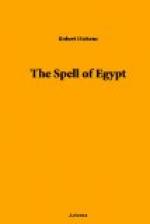Place for Queen Hatshepsu! Surely she comes to a sound of flutes, a merry noise of thin, bright music, backed by a clashing of barbaric cymbals, along the corridors of the past; this queen who is shown upon Egyptian walls dressed as a man, who is said to have worn a beard, and who sent to the land of Punt the famous expedition which covered her with glory and brought gold to the god Amun. To me most feminine she seemed when I saw her temple at Deir-el-Bahari, with its brightness and its suavity; its pretty shallowness and sunshine; its white, and blue, and yellow, and red, and green and orange; all very trim and fanciful, all very smart and delicate; full of finesse and laughter, and breathing out to me of the twentieth century the coquetry of a woman in 1500 B.C. After the terrific masculinity of Medinet-Abu, after the great freedom of the Ramesseum, and the grandeur of its colossus, the manhood of all the ages concentrated in granite, the temple at Deir-el-Bahari came upon me like a delicate woman, perfumed and arranged, clothed in a creation of white and blue and orange, standing—ever so knowingly—against a background of orange and pink, of red and of brown-red, a smiling coquette of the mountain, a gay and sweet enchantress who knew her pretty powers and meant to exercise them.
Hatshepsu with a beard! Never will I believe it. Or if she ever seemed to wear one, I will swear it was only the tattooed ornament with which all the lovely women of the Fayum decorate their chins to-day, throwing into relief the smiling, soft lips, the delicate noses, the liquid eyes, and leading one from it step by step to the beauties it precedes.
Mr. Wallis Budge says in his book on the antiquities of Egypt: “It would be unjust to the memory of a great man and a loyal servant of Hatshepsu, if we omitted to mention the name of Senmut, the architect and overseer of works at Deir-el-Bahari.” By all means let Senmut be mentioned, and then let him be utterly forgotten. A radiant queen reigns here—a queen of fantasy and splendor, and of that divine shallowness—refined frivolity literally cut into the mountain—which is the note of Deir-el-Bahari. And what a clever background! Oh, Hatshepsu knew what she was doing when she built her temple here. It was not the solemn Senmut (he wore a beard, I’m sure) who chose that background, if I know anything of women.
Long before I visited Deir-el-Bahari I had looked at it from afar. My eyes had been drawn to it merely from its situation right underneath the mountains. I had asked: “What do those little pillars mean? And are those little doors?” I had promised myself to go there, as one promises oneself a bonne bouche to finish a happy banquet. And I had realized the subtlety, essentially feminine, that had placed a temple there. And Menu-Hotep’s temple, perhaps you say, was it not there before the queen’s? Then he must have possessed a subtlety purely feminine, or have been advised by one of his wives in his building operations, or by some favorite female slave. Blundering, unsubtle man would probably think that the best way to attract and to fix attention on any object was to make it much bigger than things near and around it, to set up a giant among dwarfs.




